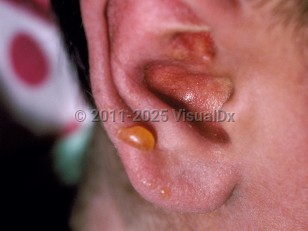Acute GVHD in infants is usually secondary to engraftment of birthing-parent transmitted or transfusion-derived T lymphocytes in infants with severe combined immunodeficiency (SCID). Another similar condition includes transfusion-associated GVHD, when SCID patients receive nonirradiated blood products causing skin rash, fever, diarrhea, pancytopenia, and jaundice.
Time course for GVHD for post-allogeneic stem cell transplant:
Acute GVHD –
- Classic acute GVHD: less than 100 days after transplant (typically within 2-4 weeks of stem cell transplant) with morbilliform, erythroderma, toxic epidermal necrolysis-like picture
- Late-onset acute GVHD: present after 100 days
- Classic: without preceding acute GVHD, develop more than 100 days after transplant (mean onset of 4 months)
- Overlap: features of both acute and chronic GVHD occurring more than 100 days after transplant
- Skin – Acute disease typically presents as a morbilliform eruption that may progress to erythroderma or a toxic epidermal necrolysis-like presentation. Jaundice can be seen with liver involvement.
- Liver – Hepatic involvement of acute GVHD present as a cholestatic pattern with elevated alkaline phosphatase, gamma-glutamyl transferase, hepatomegaly, and pain. Serum markers of severity include elevation in serum bilirubin, which can cause clinically observable jaundice.
- GI: Acute GVHD can affect both the upper and lower GI tract, presenting as diarrhea (watery), nausea, vomiting, and abdominal pain. Electrolyte abnormalities from diarrhea and GI ileus and bleeding can occur.
Modified Glucksberg-Seattle Criteria:
- Grade I:
- Skin: rash covering < 25% of body surface area (BSA)
- Liver: bilirubin 2-3 mg/dL
- GI: diarrhea < 500 mL/day or persistent nausea
- Grade II:
- Skin: rash covering 25%-50% of BSA
- Liver: bilirubin 3.1-6 mg/dL
- GI: diarrhea 500-1000 mL/day
- Grade III:
- Skin: rash covering > 50% of BSA
- Liver: bilirubin 6.1-15 mg/dL
- GI: diarrhea 1000-1500 mL/day
- Grade IV:
- Skin: generalized erythroderma with bullae
- Liver: bilirubin > 15 mg/dL
- GI: diarrhea > 1500 mL/day or severe abdominal pain with or without ileus
- Index A: Mild skin involvement without significant liver or GI involvement
- Index B: Moderate skin involvement or mild liver / GI involvement
- Index C: Severe skin involvement or moderate liver / GI involvement
- Index D: Severe liver / GI involvement or multiorgan severe involvement



